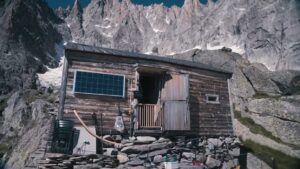Gwen Moffat is a name that lines the halls of British climbing history. As Britain’s first female mountain guide and a prolific first ascensionist, Moffat is nothing short of legendary.
Operation Moffat, inspired by her book Space Below My Feet, catalogs her most remarkable adventures and dives deep into her philosophy on life, struggle, and the mountains. To her, they are all one and the same.
Who is Gwen Moffat?

Photo: Claire Jane Carter/@cj_cart
Ask the 97-year-old who she is and the answer is long: farmer, rancher, field hand, hotel worker, crime novelist, reporter — “I’ve done practically anything that was going!” she says. “And then it comes down to, really, just one thing,” her voice turns sober, “and that was guiding and then writing about it.”
As Moffat tells it, fear doesn’t come naturally to her. “I’ve only been benighted about…three times, I think.” Given her cool confidence and apparent tenacity through a cornucopia of challenges, one is inclined to believe that statement.
Early years

Gwen Moffat and her climbing cronies in Yorkshire, c. 1941. Photo: courtesy of the Pinnacle Club
Moffat was 16 when World War II ushered her family out of Brighton and into Yorkshire. She learned to climb in the hills there, where she “had complete freedom”.
During the war, she filled several roles for the British Army before running away to mid-Wales to climb and work the odd job. She was, by all definitions, an Army deserter. That is, until her delinquent status got in the way of her aspirations.
At the age of 24, Moffat very briefly returned to the military to obtain a passport. Her destination? The Alps.
Britain’s first female mountain guide

Photo: JR Lees, courtesy of the Pinnacle Club
Moffatt leaned into the task of amassing a wealth of mountaineering experience as soon as she got to the Alps in the late 1940s. While she was there, she also raised her young child, worked as a hostel warden, and wrote for various publications.
In 1953, Moffat leveraged her reputation as a highly-skilled mountaineer to become a climbing guide. As a guide, she traveled throughout Europe and the U.K. In her personal time, she did her own climbing, notching notable first ascents throughout the Dolomites, Pennine Alps, and Dauphiné (or Valais) Alps.
She wrote about her experience as a guide in a Pinnacle Club Journal article titled, simply, “Guiding“:
There are times when it becomes a little boring, when the old burns across the back are wakened into new and painful fire by fresh pressure, but such episodes are remembered only as cold facts. They are swamped by other memories: of pure joy in the eyes of natural climbers on their first climb and the wonder at the end of it, memories of elderly people carefully and neatly coming up Cneifion Arete, or looking at the cushions of moss campion on the Kitchen cliffs. It’s a pleasant profession where you can make other people happy merely by doing something you enjoy yourself.
Moffat’s epilogue
She continued guiding and writing throughout the ’60s and ’70s. In 1961, she published Space Below My Feet to critical acclaim and followed it with a number of successful crime novels.
In the 1970s, she traveled to the U.S. on an assignment writing about the 8,000-kilometre California Trail. Along the way, she soon fell in love with the American Southwest, and spent the following 20 years bouncing between the U.S. and Wales climbing, writing, and adventuring.

Moffat riding Sergeant the horse during a trip to the U.S. Photo: courtesy of the Pinnacle Club
In 1990, Moffat finally settled down in the English countryside, where she could continue exploring terrain unknown to her.
Now nearing 100 years old, Moffat holds another distinction — she is the longest-standing active member of the Pinnacle Club for women climbers, which she joined in 1949.
Footnotes

Moffat hiking near Harwick, England c. 2020. Photo: Val Hennelly
Operation Moffat won the 2015 Kendal Mountain Festival People’s Choice distinction and close to 20 additional film awards.
Alex Messenger directed the film, and the BMC produced it with support from outdoor companies Rab and Lowe Alpine.
Writer Claire Carter and filmmaker Jen Randall co-star in the documentary, alongside Gwen Moffat.






